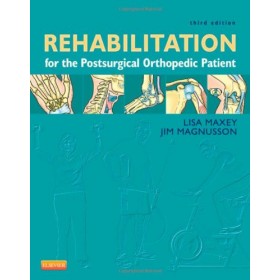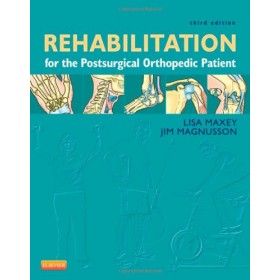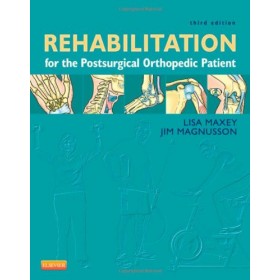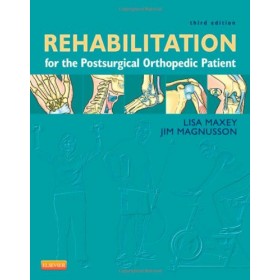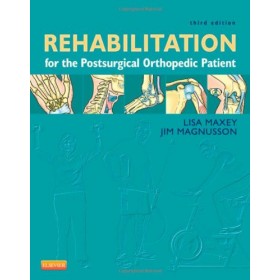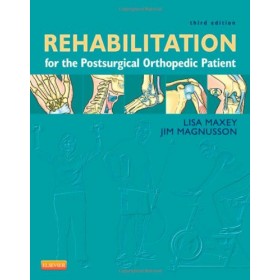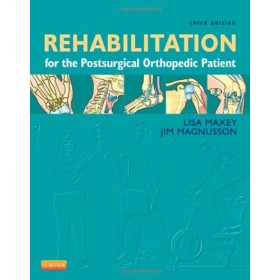Details
Share A Course: Rehabilitation for the Postsurgical Orthopedic Patient, 3rd Ed: Module 5
SKU: 775S
Do you already have access to the reading materials and only need the testing materials? Are you planning to Share A Course with someone else who already has the reading materials?
This package includes only the testing materials for the course and not the required reading materials.
These courses are offered in cooperation with Elsevier Health and utilize the hardback textbook, “Rehabilitation for the Postsurgical Orthopedic Patient, 3rd Edition", c2013 by Lisa Maxey & Jim Magnusson. Replacing 2 of our most popular courses from the 2nd Edition, this new edition provides current, evidence-based guidelines to designing effective rehabilitation strategies. Coverage of each condition includes an overview of the orthopedic patient’s entire course of treatment from pre- to post-surgery. For each phase of rehabilitation, this book describes the postoperative timeline, the goals, potential complications and precautions, and appropriate therapeutic procedures.
These courses are essential to both inpatient and outpatient physical and occupational therapists, physical and occupational therapy assistants and athletic trainers who deal with postsurgical orthopedic cases!
Module 1: covers shoulder acromioplasty, anterior capsular reconstruction, rotator cuff repair and rehabilitation, and superior labral anterior/posterior repair.
Module 2: covers total shoulder arthroplasty, extensor brevis release & lateral epicondylectomy, reconstruction of the ulnar collateral ligament with ulnar nerve transposition and platelet rich plasma therapy.
Module 3: covers primary flexor tendon repair in the digit, carpal tunnel release, transitioning the throwing athlete back to the field, and anterior cervical discectomy and fusion.
Module 4: covers posterior lumbar arthroscopic discectomy, lumbar spine fusion and lumbar spine disc replacement.
Module 5: covers total hip arthroplasty, hip arthroscopy, hip ORIF, ACL reconstruction and arthroscopic lateral retinaculum release.
Module 6: covers meniscectomy and meniscal repair, autologous chondrocyte implantation, ORIF of the patella, total knee arthroplasty and lateral ligament repair of the ankle.
Module 7: covers ORIF of the ankle, ankle arthroscopy, achilles tendon repair and bunionectomies.
Course Length: 10.0 contact hours
Instructional Level: Intermediate
This package includes only the testing materials for Module 5 and NOT the required reading materials.
Rehabilitation for the Postsurgical Orthopedic Patient, 3rd Ed: Module 5
GOALS AND OBJECTIVES
Course Goals: This course is intended to instruct the student through self paced study on providing intervention for the patient after total hip arthroplasty including mini invasive total hip arthroplasty, hip arthroscopy, open reduction internal fixation (ORIF) of the hip, anterior cruciate ligament (ACL) reconstruction, and arthroscopic lateral retinaculum release.
Student Objectives:
At the end of this course, the student will be able to:
1. Analyze 4 different patient populations and the possibility of a non-cemented hip implant.
2. Understand the surgical procedure of total hip arthroplasty (THA).
3. Analyze the position of the patient after posterolateral THA.
4. Analyze the surgical procedure for anterolateral THA.
5. Understand contraindications after anterolateral THA.
6. Understand contraindications after trochanteric osteotomy of the hip.
7. Analyze isometric hip abduction after THA.
8. Understand hospital discharge criteria after THA.
9. Analyze the procedure for staple removal after THA.
10. Understand 4 sports and their relationship to THA.
11. Understand the surgical procedure behind minimally invasive THA.
12. Analyze the proper position of the acetabular component of minimally invasive THA.
13. Analyze precautions after minimally invasive THA.
14. Evaluate 4 different nerves and their nerve roots in relationship to MMT.
15. Understand a CAM lesion as viewed on a plain film radiograph.
16. Understand positioning the patient for hip arthroscopy.
17. Examine what portals are used for hip arthroscopy.
18. Understand the relationship between 4 different nerves and hip arthroscopy procedures.
19. Analyze the role of the hip labrum in hip stability.
20. Analyze 4 different medications after hip arthroscopy.
21. Understand return to function after hip ORIF.
22. Understand the anatomy of the blood supply to the femoral head and neck.
23. Evaluate the arthokinematics of the hip after hip ORIF.
24. Understand hip precautions after hip ORIF.
25. Understand 4 different surgical procedures for hip ORIF and the level of difficulty of each.
26. Understand the relationship between the intertrochanteric region and the femoral shaft/neck.
27. Evaluate proper healing time after hip ORIF.
28. Analyze the relationship between intramedulary nailing techniques and 4 types of hip fracture.
29. Analyze the position of patient on operating table for hip ORIF.
30. Analyze the order of procedures during hip ORIF.
31. Understand weight bearing status after hip ORIF.
32. Understand home health therapy rehabilitation protocols after hip ORIF.
33. Understand the progression of rehabilitation after hip ORIF.
34. Analyze the patella tendon graft used in an ACL reconstruction.
35. Understand the relationship between bracing and early ACL rehabilitation.
36. Analyze closed and open chain knee exercises after ACL reconstruction.
37. Understand the effect of McConnell patella femoral taping.
38. Analyze the position of the arthroscope in lateral retinaculum release.
39. Understand the relationship between soft tissue mobilization and lateral structures of the knee after arthroscopic lateral retinaculum release.
